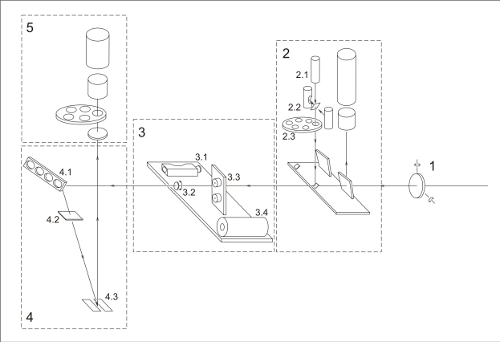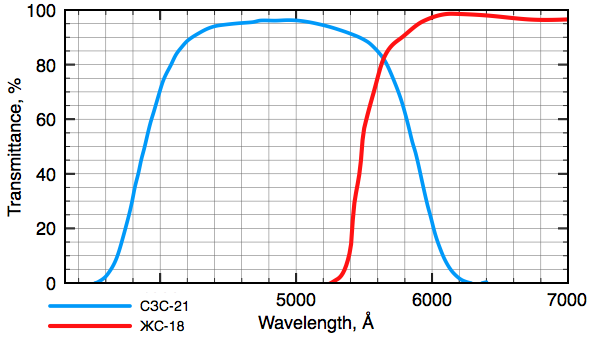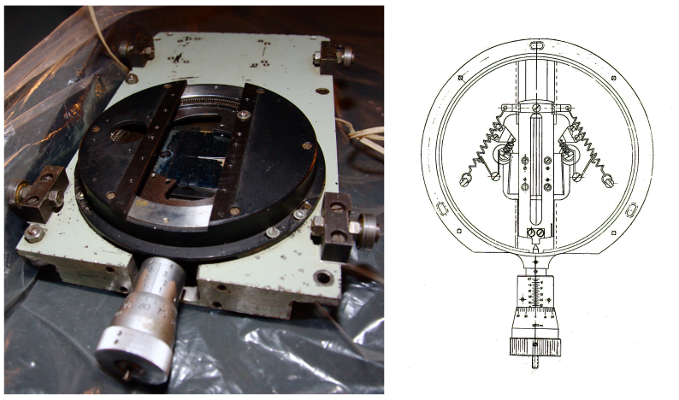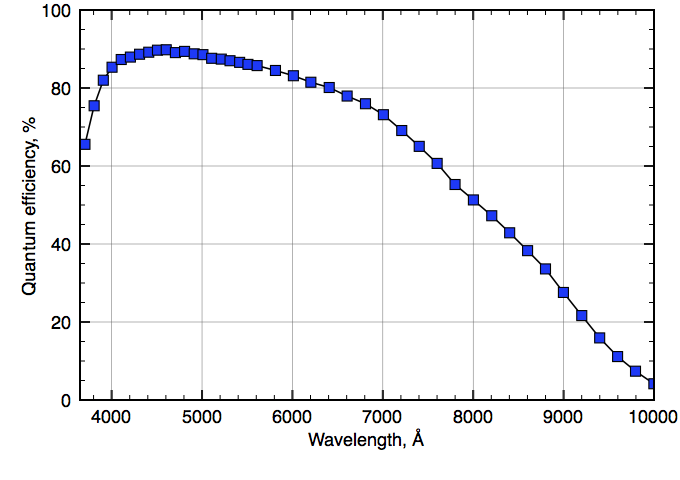Main Stellar Spectrograph of the BTA
2. Technical characteristics of the spectrograph
The spectrograph is installed in the Nasmyth focus of the BTA telescope, the equivalent focal length is 186 m (F/31). The preslit part of the spectrograph is located on the 4th floor of the telescope column and is common with other instruments of the Nasmyth-2 focus. Figure 2 shows the optical configuration of the MSS. The preslit device unit is marked by number 3. Here on the mobile platform two circular (Najdenov, Chuntonov 1976) and linear polarization analyzers (Najdenov et al. 2007), rotating phase plate, and iodine cell are mounted.


Fig. 2. Optical configuration of the MSS. The numbers mark: 1 — the local Nasmyth-2 focus corrector, 2 — the unit of calibration devices, 2.1 — halogen flat field lamp, 2.2 — Th-Ar comparison spectrum lamp, 2.3 — the unit of changeable diaphragms, 3 — unit of the preslit devices of the Nasmyth-2 focus, 3.1 — circular polarisation analysers (Najdenov, Chountonov 1976), 3.2 — rotating phase plate of the new design polarisation analyser (Chountonov 2004), 3.3 — the phase plate unit of the polarization analyzer for the NES (Najdenov et al. 2007), 3.4 — iodine cell, 4 — slit unit of the MSS, 4.1 — deflecting mirror on the Z axis, 4.2 — replaceable order separation filter, 4.3 — the spectrograph slit, 5 — the unit of the slit guide devices.
Fig. 2. Optical configuration of the MSS. The numbers mark: 1 — the local Nasmyth-2 focus corrector, 2 — the unit of calibration devices, 2.1 — halogen flat field lamp, 2.2 — Th-Ar comparison spectrum lamp, 2.3 — the unit of changeable diaphragms, 3 — unit of the preslit devices of the Nasmyth-2 focus, 3.1 — circular polarisation analysers (Najdenov, Chountonov 1976), 3.2 — rotating phase plate of the new design polarisation analyser (Chountonov 2004), 3.3 — the phase plate unit of the polarization analyzer for the NES (Najdenov et al. 2007), 3.4 — iodine cell, 4 — slit unit of the MSS, 4.1 — deflecting mirror on the Z axis, 4.2 — replaceable order separation filter, 4.3 — the spectrograph slit, 5 — the unit of the slit guide devices.


Fig. 3. The diagram of the order separation filter transmission, SZS-21 (blue) and ZhS-18 (red).
Fig. 3. The diagram of the order separation filter transmission, SZS-21 (blue) and ZhS-18 (red).
A slit unit consists of a mirror, redirecting the light from the telescope and from the calibration sources at an angle of 65° to the axis of the telescope focus into the slit, an order separating filter, a slit and a shutter (Item 4 in Fig. 2). A secondary mirror is mounted in the frame in a moving carriage, it has a protective MgF2 coating. A coloured antireflection glasses FS-6 (near-UV region), SZS-21 (blue region) or ZhS-18 (red region) are in use as the order separating filters. The transmission curves of the SZS-21 and ZhS-18 glasses are shown in Fig. 3.


Fig. 4. The physical configuration and the scheme of the standard MSS slit.
Fig. 4. The physical configuration and the scheme of the standard MSS slit.
A replaceable slit unit allows work with a standard slit produced by the LOMO (Fig. 4) or with a new slit, designed by Chountonov G.A. (Chountonov 2004, Fig. 5). In the first case, the slit height is 50 mm, and its width may be variable. In the second case, the slit has a fixed width (0.5″ in the projection on the celestial sphere) and is structurally aligned with the synthetic birefringent crystal and an image slicer, which limits its application only to the tasks of spectropolarimetry. The aperture with the diameter of 5 arcseconds (projected on the sky) determines the height of the slit.


Fig. 5. The physical configuration and the scheme of the MSS slit with an image slicer.
Fig. 5. The physical configuration and the scheme of the MSS slit with an image slicer.
The mirror collimator of the spectrograph has an aperture of 310 mm (the collimated beam diameter of 258 mm), its focal length is 7928 mm. Other parameters of the spectrograph are given in Table 1.
Table 1. The main parameters of the MSS optical system.
| The angle of the beam deviation to the Z axis | 65° |
| Collimator | |
| Focal length | 7928.7 mm |
| Aperture | 310 mm |
| The angle of inclination of the axis | 3° |
| The angle between the axes of the collimator and the camera | 45° |
| Camera No. 2 | |
| Focus | 604 mm |
| Mirror diameter | 700 mm |
| Corrector diameter | 405 mm |
| Flat mirror diameter | 120 mm |
One of the three diffraction gratings may be used as a dispersing element. Their parameters are given in Table 2 (Panchuk 2001).
Table 2. The parameters of the MSS diffraction gratings.
| Blaze angle | 8.0° | 15.5° | 24.7° | 24.7° |
| Working order | I | II | II | III |
| Recommended spectral range, Å | 4300-6500 | 3100-5600 | 5600-9000 | 4000-4900 |
| Mean reciprocal dispersion (Å/mm) | 26.1 | 13.2 | 13.2 | 8.8 |
The spectrograph camera has the Schmidt optical system with a quartz correction plate. Initially, the spectrograph was equipped with three cameras. The long-focus camera number 1, due to its low efficiency and because it was not adapted to work with modern light detectors is not currently used in the observations. The Schmidt aperture camera (F/1.16) is in the process of modernisation and is not used in the observations either. Camera no. 2 (F/2.3) has the Schmidt optical system with a correction plate having the diameter of 405 mm and an aperture of 700 mm. With the aid of a flat mirror, the light beam is output from the camera at an angle of 90° to its axis and is recorded at the CCD detector.


Fig. 6. Quantum efficiency of the CCD E2V CCD 42-90, used in the MSS.
Fig. 6. Quantum efficiency of the CCD E2V CCD 42-90, used in the MSS.
Since 2010, a CCD system based on the E2V CCD42-90 chip, sized 2048 × 4600 pixels is used. One square element has a size of 5.13 microns. This CCD system was made at the Advanced Design Laboratory of the SAO, its photovoltaic parameters are given in Table 3, the curve of its sensitivity — in Fig. 6.
Table 3. Photovoltaic characteristics of the CCD system based on E2V CCD 42-90.
| Conversion factor, e-/ADU | Output A | gain = 1 | 1.92 |
| gain = 4 | 0.462 | ||
| Output B | gain = 1 | 1.90 | |
| gain = 4 | 0.462 | ||
| Readout noise, e- | Readout speed 100 kpix/s | ||
| Output A | gain = 1 | 5.4 | |
| gain = 4 | 3.46 | ||
| Output B | gain = 1 | 3.70 | |
| gain = 4 | 3.0 | ||
| Readout speed 400 kpix/s | |||
| Output A | gain = 1 | 6.75 | |
| gain = 4 | 4.86 | ||
| Output B | gain = 1 | 6.45 | |
| gain = 4 | 4.82 | ||
| Full-well capacity, e- | 118 000 | ||
| Dynamic range | gain = 1 | 32 000 | |
| gain = 4 | 20 000 | ||
Literature
- Najdenov I.D., Chountonov G.A., Soobsheniya SAO, 16, 63 (1975) (in Russian).
- Naidenov I.D., Panchuk V.E., Yushkin M.V. Astrophysical Bulletin, 62, 296 (2007).
- Panchuk V.E., Preprint SAO no.154 (2001) (in Russian).
- BTA telescope, Technical description, Book 4. The main stellar spectrograph, Leningrad: LOMO (1974) (in Russian).
- Chountonov G.A. in: "Magnetic Stars", Proceed. of Intern. Conf. (Eds.: Yu. Glagolevskij, D. Kudryavtsev, I. Romanyuk), Nizhny Arkhyz, 286 (2004)



